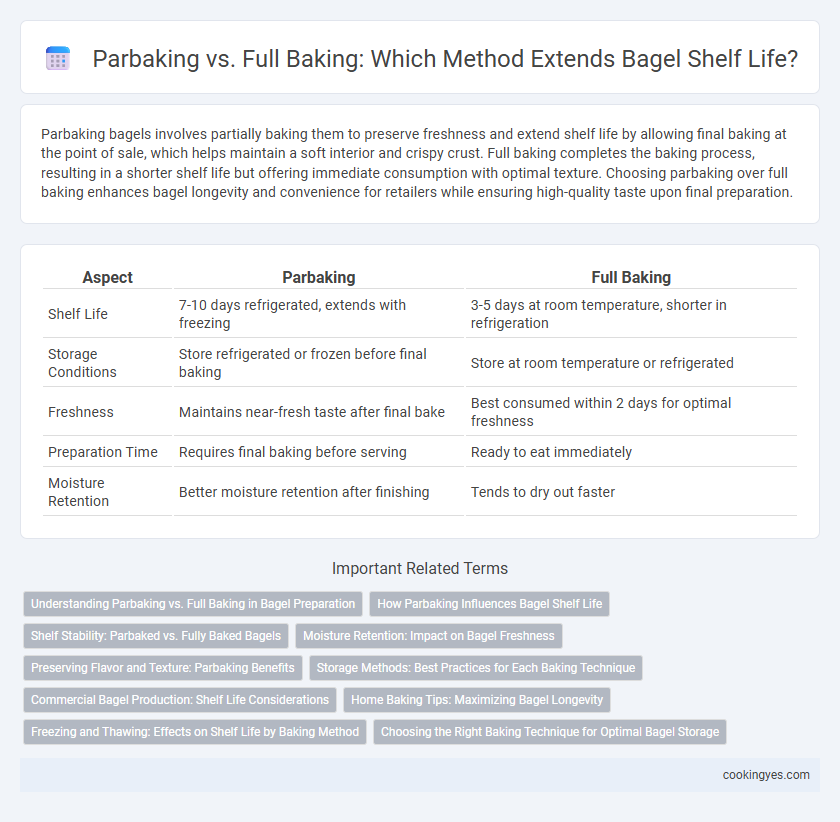Parbaking bagels involves partially baking them to preserve freshness and extend shelf life by allowing final baking at the point of sale, which helps maintain a soft interior and crispy crust. Full baking completes the baking process, resulting in a shorter shelf life but offering immediate consumption with optimal texture. Choosing parbaking over full baking enhances bagel longevity and convenience for retailers while ensuring high-quality taste upon final preparation.
Table of Comparison
| Aspect | Parbaking | Full Baking |
|---|---|---|
| Shelf Life | 7-10 days refrigerated, extends with freezing | 3-5 days at room temperature, shorter in refrigeration |
| Storage Conditions | Store refrigerated or frozen before final baking | Store at room temperature or refrigerated |
| Freshness | Maintains near-fresh taste after final bake | Best consumed within 2 days for optimal freshness |
| Preparation Time | Requires final baking before serving | Ready to eat immediately |
| Moisture Retention | Better moisture retention after finishing | Tends to dry out faster |
Understanding Parbaking vs. Full Baking in Bagel Preparation
Parbaking bagels involves partially baking them before freezing, which extends shelf life by slowing staleness and preserving freshness up to several weeks when stored properly. Full baking completes the baking process, offering immediate consumption but results in a shorter shelf life, typically only a few days at room temperature. Understanding these differences helps bakeries optimize inventory management and deliver fresh bagels consistently.
How Parbaking Influences Bagel Shelf Life
Parbaking bagels involves partially baking them before freezing, which significantly extends their shelf life by slowing mold growth and staling compared to fully baked bagels. The reduced moisture content and partial cooking during parbaking help maintain texture and freshness for weeks when stored frozen. This preservation method allows retailers and consumers to enjoy bagels with a near-fresh taste after final baking at home or in-store.
Shelf Stability: Parbaked vs. Fully Baked Bagels
Parbaked bagels offer extended shelf stability by slowing moisture loss and microbial growth through partial baking and freezing, allowing fresh baking just before consumption. Fully baked bagels tend to have a shorter shelf life due to their higher moisture content and greater susceptibility to staling and mold during storage. Choosing parbaked bagels enhances inventory flexibility and reduces waste in retail and food service operations by maintaining quality longer.
Moisture Retention: Impact on Bagel Freshness
Parbaking bagels preserves higher moisture content by partially cooking the dough, resulting in extended freshness and a softer texture compared to fully baked bagels. Full baking removes more moisture, leading to a drier product that stales faster and has a shorter shelf life. Optimal moisture retention in parbaked bagels supports prolonged softness and flavor stability during storage.
Preserving Flavor and Texture: Parbaking Benefits
Parbaked bagels offer extended shelf life by partially baking the dough, which preserves moisture and maintains the chewy texture typical of fresh bagels. This method locks in flavor compounds better than full baking, reducing staleness during storage or freezing. Retailers benefit from fresher-tasting bagels with a consistent crust quality when finishing the baking process on-demand.
Storage Methods: Best Practices for Each Baking Technique
Parbaked bagels benefit from refrigeration or freezing immediately after parbaking to extend shelf life, maintaining firmness and preventing staleness before final baking. Fully baked bagels should be stored in airtight containers at room temperature for up to two days or frozen for longer preservation, ensuring moisture retention and flavor stability. Proper storage methods tailored to each baking stage maximize freshness and quality, reducing waste and maintaining optimal texture.
Commercial Bagel Production: Shelf Life Considerations
Parbaking bagels in commercial production extends shelf life by allowing partial baking that preserves moisture and slows staling, enabling longer storage before final baking. Full baking completes the baking process but results in a shorter shelf life due to accelerated moisture loss and crumb firming. Optimizing parbaking conditions ensures product quality retention and efficient distribution in commercial bagel supply chains.
Home Baking Tips: Maximizing Bagel Longevity
Parbaking bagels extends shelf life by allowing partial baking before freezing, preserving texture and flavor better than fully baked bagels frozen fresh. When reheated at home, parbaked bagels finish baking, resulting in a fresher taste and chewier crust compared to reheating fully baked bagels, which may become stale or dry quickly. For optimal longevity, store parbaked bagels in airtight containers in the freezer, then bake directly from frozen to maximize freshness and enjoyment.
Freezing and Thawing: Effects on Shelf Life by Baking Method
Parbaked bagels retain moisture better during freezing, extending shelf life by minimizing freezer burn and texture degradation compared to fully baked bagels. Thawing parbaked bagels followed by final baking ensures freshness and optimal chewiness, while fully baked bagels may become stale or soggy upon thawing. Freezing fully baked bagels often leads to a shorter shelf life due to quicker moisture loss and crumb firmness changes.
Choosing the Right Baking Technique for Optimal Bagel Storage
Parbaking bagels involves partially baking them before freezing, which extends shelf life by preventing staling and maintaining moisture, ideal for long-term storage up to several weeks. Full baking results in a finished product with a shorter freshness window, typically lasting two to three days at room temperature before becoming stale. Selecting parbaking is optimal for commercial distribution or batch preparation, while full baking suits immediate consumption and local sales.
Parbaking vs Full baking for bagel shelf life Infographic

 cookingyes.com
cookingyes.com